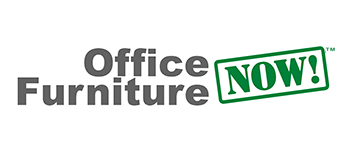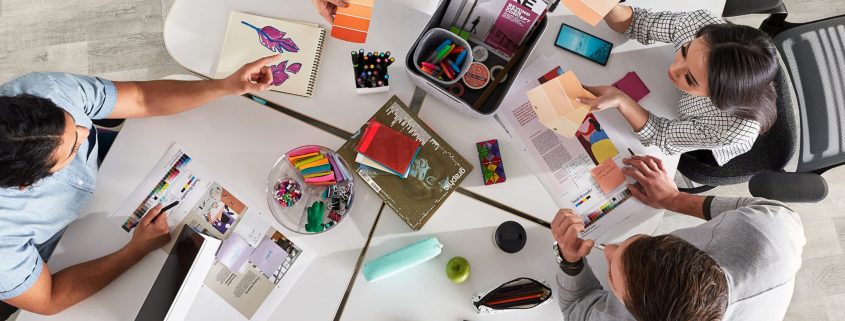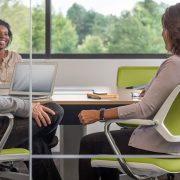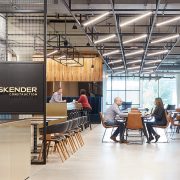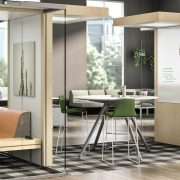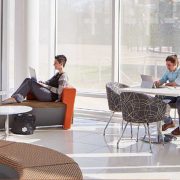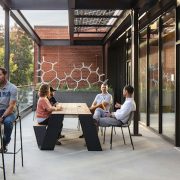Instilling A Sense Of Community At Work
Instilling a sense of community at work is more important than ever to the future of work. When your employees feel they are contributors to a community, they will create a happier, healthier, and more engaged workforce. And a better bottom line. Community in the workplace is an important part of hybrid office design and the future of work.
The best workplaces not only support collaborative work but also the growing need for focus time. As the workforce becomes five generations in one space, designing for high-performing teams as well as individuals will become a significant player in the workspace of the future.
Flexible work is most likely here to stay. With five generations collaborating within the workforce, finding meaningful ways to connect must become part of your infrastructure. The changing values of younger team members were a challenge before the pandemic disruption. But hybrid workspace design thrives on team building, which will mean different things to each generation, but there is a pattern here….and its loyalty:
- Boomers are loyal to the team. They value going the extra mile and view careers as self-worth.
- Generation X are loyal to their manager. They exceed expectations to deliver results but perceive careers as one component of their identity.
- Millennials are loyal to colleagues. They expect equitable treatment and see careers as an opportunity to contribute.
- Generation Z is loyal to the experience and invested in their careers. They see careers as growth.
COMMUNITY BUILDING
Establishing a sense of community at work means finding bridge points with these similarities by creating connections through activities, communication, mentoring, and rituals that speak to your business goals. Begin by leveraging the differences, shared contributions, and ideals of your multigenerational teams into a unique collaboration of ideas, and talking points with surprising results. Here are some suggestions to build an inclusive culture:
DESIGN THE WORKSPACE FOR CONNECTION: Incorporate a hybrid office design that mixes collaborative, meeting, and focus spaces, in addition to informal social settings. Open up that breakroom to a neutral zone by creating a full-fledged coffee bar aesthetic that encourages a relaxed cafe culture bonding experience. Especially for flex workers who may be working only a few days at a time in the office.
USE STORYTELLING: People are culturally and biologically predisposed to respond to stories. Brand storytelling is a key player in the current trend of user experience design. With a diverse team at work, stories can help your team empathize with one another and feel connected, especially during times of change. Without putting people on the spot, solicit employee testimonials and ask leaders to weave stories into their communications to emphasize community.
IMPLEMENT ERGs: Employee Resource Groups (ERGs) provide a safe place to connect and share with like-minded coworkers. ERGs work best when they have the autonomy to create and maintain their own groups without feeling too much oversight from leadership or HR. Some popular community-building resource groups include networks for diversity and inclusion, women, working parents, interests in sustainability, advocacy, young professionals, book clubs, and more!
LEVERAGE DIGITAL CONNECTION: Slack channels or workplace social media interest groups can be a great way to keep flex workers and in-house employees connected. Chat channels for employees working from the same state can talk about local events and plan virtual or in-person meetups. Social media tools can also connect employees based on their interests and goals: fitness, skill upgrades, and expertise sharing. Once in a group, participants post questions, share stories, and provide encouragement.
BUILD MENTOR/PEER COACHING PROGRAMS: Mentorship has been associated with increased satisfaction at work and greater feelings of acceptance within the organization, and naturally creates a different type of bond between employees. With five generations on board, peer coaching and mentorship can provide support and skill upgrades across the board. It can also create a more diverse and inclusive community among women and minorities.
DESIGN A STELLAR ONBOARDING EXPERIENCE: Welcome new employees into the community with intentional activities designed to create connection. Schedule coffee chats or lunch with different team members each day during their first week. Establish connections with senior leaders through welcome emails. The goal is to create a people-focused caring community from the top down. No hierarchy.
INSTATE A 5 MINUTE “CHECK IN” RITUAL: Encourage employees to intentionally connect with others, ask each other how they are or what they did over the weekend, talk about their pets, and discuss hobbies, or passions that energize them.
CREATE RITUALS that employees can look forward to. Aside from celebrating business wins, find ways to acknowledge anything from celebrating work anniversaries or birthdays to hosting healthy Taco Tuesdays, movie/TV show reviews Mondays, or First Friday pizza. Establish biweekly virtual chats anyone can participate in to take a break, talk about non-work-related topics, and meet people from departments they don’t work with daily.
ENCOURAGE CROSS-CONNECTIONS: Too often, we only really get to know the people in our direct department. But “weak ties” are also essential to nurturing a community culture. Set up random meetings between coworkers who don’t typically work together to discuss their goals for professional growth. Often outsiders can provide unthought-of solutions to complex departmental issues.
VOLUNTEER TOGETHER: Pick a cause that’s close to your organization’s mission, a local charity, or even an employee’s passion project. Get employees excited about participating with lots of communication beforehand and a t-shirt to wear during the event. For flex workers, include virtual volunteer opportunities.
MAINTAIN HIGH-TOUCH COMMUNICATIONS: Organizations that maintain regular communication with employees tend to have stronger communities. During the pandemic, companies that regularly communicated and were transparent with employees built trust and loyalty versus those that kept employees in the dark. Leadership communication is vital. Leaders can create community by regularly sharing the organization’s mission and how employees’ work ties into it.
SUMMARY
Instilling a sense of community at work by engaging your teams with shared company values takes time and careful nurturing. Finding your ‘why’ as a brand will help you navigate it with more purpose. Just know that deck may be stacked against you on some inherent generational issues. But there are always opportunities to override those challenges.
According to a survey following the pandemic, 25% of Millennials and 22%of Generation Z would like to work in the office “a little to a lot less often” than they did before. Less than half of Millennials (47%) and less than half of members of Generation Z (48%) think businesses are having a positive impact on society. The Great Resignation is likely to continue, with 36% of Millennials and 53% of Generation Z saying they will leave their current employers within two years. Due to the pandemic, respondents also have felt immense stress. The survey showed that 41% of Millennials and 46% of Generation Z feel stressed all or most of the time.
That last statement is a real indicator that you must design an office space worthy of their effort, time, and contributions. Leveling this angst with a solid community-building effort, combined with a highly functional hybrid office design that addresses connection at every opportunity will give your team a solid foundation for longevity.
 HYBRID OFFICE DESIGN is so important for collaboration and connection. There are so many mobile furniture options that allow teams to connect, disconnect and reconnect to build community. Office furniture makers are developing some very clever furnishings to create communities at work. Contact us at 512-448-3769 or experts@officefurniturenow.com
HYBRID OFFICE DESIGN is so important for collaboration and connection. There are so many mobile furniture options that allow teams to connect, disconnect and reconnect to build community. Office furniture makers are developing some very clever furnishings to create communities at work. Contact us at 512-448-3769 or experts@officefurniturenow.com
